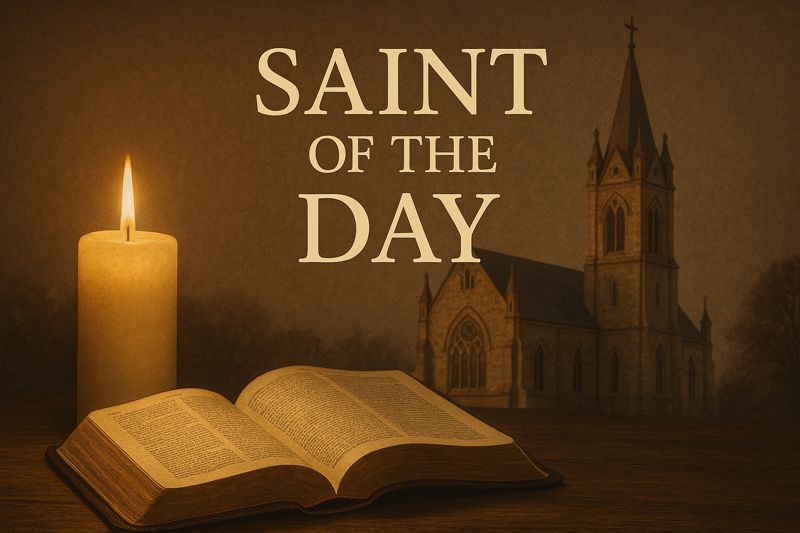Saint of the Day for 3 January

Saint of the Day 3 January: Celebrating the Lives of the Church’s Saints
Every day, the Catholic Church honors a saint or blessed who stood out for their faith, dedication, and love for God. The Saint of the Day is an opportunity for the faithful to learn more about the history of the Church and be inspired by the witness of these men and women who lived according to Christ’s teachings.
The Meaning of the Saint of the Day
The celebration of the Saint of the Day is a Church tradition that helps us remember those who were examples of faith and holiness. Saints may have been martyrs who gave their lives defending their faith, missionaries who spread the Gospel, or ordinary people who lived in deep communion with God through simplicity.
Learning about each saint’s story inspires us to live with more love, patience, and hope. It also reminds us that we are all called to holiness.
Why Do We Celebrate the Saints?
Saints serve as models of Christian life. Their stories show us that, despite challenges, it is possible to live according to God’s will. Moreover, the faithful often seek the intercession of saints, believing that they are close to God and can pray for our needs.
Following the Saint of the Day is a way to strengthen our spiritual journey and learn from those who dedicated their lives to serving God. May we follow their examples and strive each day to live with greater love, faith, and hope!
🙏 May today’s Saint of the Day intercede for us and inspire us to live according to God’s will!
Of Greek origins, Anterus was Pope for only 40 days. He was martyred in 236 under Emperor Maximinus the Thracian for collecting the Acts of the martyrs in the archives of the Church of Rome, so that they would not be dispersed. He was the first Pope to be buried in the catacombs of St. Callixtus.
Born in Licata, in 1649, of the noble Sicilian family of Lampedusa, he renounced his title in favor of his brother and became a Theatine religious. Precursor of the liturgical reform, he was named cardinal by Pope Clement XI in 1712. Pope St. John Paul II proclaimed him a Saint in 1986.
Telesphore was an anchorite in Egypt and Palestine. He reigned from 125 to 136. He established the Midnight Mass at Christmas with the song of Gloria in excelsis Deo, the celebration of Easter on Sunday, and fixed the Lenten fast. He also worked to counter Gnostic heresy, and died a martyr.
Liturgical Calendar
3 January: Christmas Weekday
Memorial
Today's Readings and Gospel
Reading 1 :
1 John 2:29–3:6
Alleluia :
John 1:14a, 12a
Gospel:
John 1:29-34
Liturgical vestments: White
“Let us celebrate the feast day, on which the great and eternal Day came into this brief and temporal day of ours. He it is who was made for us redemption.” (Saint Augustine)
“The Earth is restored to good order by virtue of the fact that it is opened up to God, it obtains its true light anew. The song of the angels is an expression of joy over the fact that Heaven and Earth are once more united to God.” (Benedict XVI)
“After agreeing to baptize him along with the sinners, John the Baptist (…) pointed Jesus out as the ‘Lamb of God, who takes away the sin of the world’ (Jn 1:29). By doing so, he reveals that Jesus is at the same time the suffering Servant who (…) bears the sin of the multitudes, and also the Paschal Lamb, the symbol of Israel's redemption at the first Passover (Ex 12:3-14). Christ's whole life expresses his mission: ‘to serve, and to give his life as a ransom for many’ (Mk 10:45).” (Catechism Of The Catholic Church, Nº 608)
The Evangelist John, unlike the other three, does not describe the event, but proposes to us the witness of John the Baptist. He was the first witness of Christ. God had called him and prepared him for this. The Baptist cannot hold back the urgent desire to bear witness to Jesus and declares: “I have seen and have borne witness” (v. 34). John saw something shocking, that is, the beloved Son of God in solidarity with sinners; and the Holy Spirit made him understand this unheard-of novelty, a true reversal. In fact, while in all religions it is man who offers and sacrifices something to God, in the event Jesus is God Who offers His Son for the salvation of humanity. John manifests his astonishment and his consent to this newness brought by Jesus, through a meaningful expression that we repeat each time in the Mass: “Behold the Lamb of God, Who takes away the sin of the world!” (v. 29). (…) Let us learn from John the Baptist not to assume that we already know Jesus, that we already know everything about Him (cf. v. 31). This is not so. Let us pause with the Gospel, perhaps even contemplating an icon of Christ, a “Holy face”. Let us contemplate with our eyes and yet more with our hearts; and let us allow ourselves to be instructed by the Holy Spirit, Who tells us inside: It is He! He is the Son of God made lamb, immolated out of love. (Angelus, 19 January 2020)